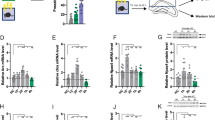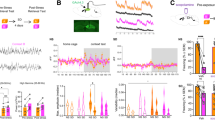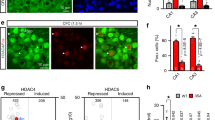Abstract
Emotional memory is a rapidly acquired and persistent form of memory, and its robustness is in part determined by the initial strength of the memory. Here, we provide new evidence that the protein phosphatase calcineurin (CaN), a potent negative regulator of neuronal signaling that is known to constrain learning and memory, critically regulates the establishment of emotional memory through mechanisms involving the immediate early gene Zif268 (also known as Egr1). We found that CaN is inhibited in the amygdala during the establishment of aversive memory, but Zif268 is activated. Using inducible transgenesis in mice, we further saw that CaN inhibition and Zif268 overexpression during memory establishment strengthen the memory trace and enhance its resistance to extinction. We found that CaN inhibition correlates with increased Zif268 expression and that a common pool of proteins is regulated in the amygdala after CaN inhibition and Zif268 overexpression. Together, these findings reveal a previously unknown mechanism for the control of emotional memory that depends on CaN and Zif268.
This is a preview of subscription content, access via your institution
Access options
Subscribe to this journal
Receive 12 print issues and online access
$209.00 per year
only $17.42 per issue
Buy this article
- Purchase on Springer Link
- Instant access to full article PDF
Prices may be subject to local taxes which are calculated during checkout







Similar content being viewed by others
References
Phelps, E.A. & LeDoux, J.E. Contributions of the amygdala to emotion processing: from animal models to human behavior. Neuron 48, 175–187 (2005).
Dudai, Y. Molecular bases of long-term memories: a question of persistence. Curr. Opin. Neurobiol. 12, 211–216 (2002).
Eisenberg, M., Kobilo, T., Berman, D.E. & Dudai, Y. Stability of retrieved memory: inverse correlation with trace dominance. Science 301, 1102–1104 (2003).
Abel, T., Martin, K.C., Bartsch, D. & Kandel, E.R. Memory suppressor genes: inhibitory constraints on the storage of long-term memory. Science 279, 338–341 (1998).
Han, J.H. et al. Neuronal competition and selection during memory formation. Science 316, 457–460 (2007).
Mansuy, I.M., Mayford, M., Jacob, B., Kandel, E.R. & Bach, M.E. Restricted and regulated overexpression reveals calcineurin as a key component in the transition from short-term to long-term memory. Cell 92, 39–49 (1998).
Genoux, D. et al. Protein phosphatase 1 is a molecular constraint on learning and memory. Nature 418, 970–975 (2002).
Mansuy, I.M. & Shenolikar, S. Protein serine/threonine phosphatases in neuronal plasticity and disorders of learning and memory. Trends Neurosci. 29, 679–686 (2006).
Rusnak, F. & Mertz, P. Calcineurin: form and function. Physiol. Rev. 80, 1483–1521 (2000).
Coghlan, V.M. et al. Association of protein kinase A and protein phosphatase 2B with a common anchoring protein. Science 267, 108–111 (1995).
Yakel, J.L. Calcineurin regulation of synaptic function: from ion channels to transmitter release and gene transcription. Trends Pharmacol. Sci. 18, 124–134 (1997).
Oliveria, S.F., Dell'Acqua, M.L. & Sather, W.A. AKAP79/150 anchoring of calcineurin controls neuronal L-type Ca2+ channel activity and nuclear signaling. Neuron 55, 261–275 (2007).
Smith, K.E., Gibson, E.S. & Dell'Acqua, M.L. cAMP-dependent protein kinase postsynaptic localization regulated by NMDA receptor activation through translocation of an A-kinase anchoring protein scaffold protein. J. Neurosci. 26, 2391–2402 (2006).
Winder, D.G. & Sweatt, J.D. Roles of serine/threonine phosphatases in hippocampal synaptic plasticity. Nat. Rev. Neurosci. 2, 461–474 (2001).
Kingsbury, T.J., Bambrick, L.L., Roby, C.D. & Krueger, B.K. Calcineurin activity is required for depolarization-induced, CREB-dependent gene transcription in cortical neurons. J. Neurochem. 103, 761–770 (2007).
Hogan, P.G. & Li, H. Calcineurin. Curr. Biol. 15, R442–R443 (2005).
Limback-Stokin, K., Korzus, E., Nagaoka-Yasuda, R. & Mayford, M. Nuclear calcium/calmodulin regulates memory consolidation. J. Neurosci. 24, 10858–10867 (2004).
Rescorla, R.A. Inhibition of delay in Pavlovian fear conditioning. J. Comp. Physiol. Psychol. 64, 114–120 (1967).
Welzl, H., D'Adamo, P. & Lipp, H.P. Conditioned taste aversion as a learning and memory paradigm. Behav. Brain Res. 125, 205–213 (2001).
Bahar, A., Samuel, A., Hazvi, S. & Dudai, Y. The amygdalar circuit that acquires taste aversion memory differs from the circuit that extinguishes it. Eur. J. Neurosci. 17, 1527–1530 (2003).
Rosenblum, K., Meiri, N. & Dudai, Y. Taste memory: the role of protein synthesis in gustatory cortex. Behav. Neural Biol. 59, 49–56 (1993).
Dodge, K.L. & Scott, J.D. Calcineurin anchoring and cell signaling. Biochem. Biophys. Res. Commun. 311, 1111–1115 (2003).
Munton, R.P., Vizi, S. & Mansuy, I.M. The role of protein phosphatase 1 in the modulation of synaptic and structural plasticity. FEBS Lett. 567, 121–128 (2004).
Fleischmann, A. et al. Impaired long-term memory and NR2A-type NMDA receptor–dependent synaptic plasticity in mice lacking c-Fos in the CNS. J. Neurosci. 23, 9116–9122 (2003).
Jones, M.W. et al. A requirement for the immediate early gene Zif268 in the expression of late LTP and long-term memories. Nat. Neurosci. 4, 289–296 (2001).
Malkani, S., Wallace, K.J., Donley, M.P. & Rosen, J.B. An egr-1 (zif268) antisense oligodeoxynucleotide infused into the amygdala disrupts fear conditioning. Learn. Mem. 11, 617–624 (2004).
Malleret, G. et al. Inducible and reversible enhancement of learning, memory and long-term potentiation by genetic inhibition of calcineurin. Cell 104, 675–686 (2001).
Mansuy, I.M. et al. Inducible and reversible gene expression with the rtTA system for the study of memory. Neuron 21, 257–265 (1998).
Michalon, A., Koshibu, K., Baumgartel, K., Spirig, D.H. & Mansuy, I.M. Inducible and neuron-specific gene expression in the adult mouse brain with the rtTA2S-M2 system. Genesis 43, 205–212 (2005).
Fanselow, M.S. Conditioned and unconditional components of post-shock freezing. Pavlov. J. Biol. Sci. 15, 177–182 (1980).
Groth, R.D., Dunbar, R.L. & Mermelstein, P.G. Calcineurin regulation of neuronal plasticity. Biochem. Biophys. Res. Commun. 311, 1159–1171 (2003).
Antoni, F.A. et al. Calcium control of adenylyl cyclase: the calcineurin connection. Adv. Second Messenger Phosphoprotein Res. 32, 153–172 (1998).
Chan, G.C., Tonegawa, S. & Storm, D.R. Hippocampal neurons express a calcineurin-activated adenylyl cyclase. J. Neurosci. 25, 9913–9918 (2005).
Ahi, J., Radulovic, J. & Spiess, J. The role of hippocampal signaling cascades in consolidation of fear memory. Behav. Brain Res. 149, 17–31 (2004).
Sheng, M. & Kim, M.J. Postsynaptic signaling and plasticity mechanisms. Science 298, 776–780 (2002).
Dash, P.K., Orsi, S.A. & Moore, A.N. Sequestration of serum response factor in the hippocampus impairs long-term spatial memory. J. Neurochem. 93, 269–278 (2005).
Matheos, D.P., Kingsbury, T.J., Ahsan, U.S. & Cunningham, K.W. Tcn1p/Crz1p, a calcineurin-dependent transcription factor that differentially regulates gene expression in Saccharomyces cerevisiae. Genes Dev. 11, 3445–3458 (1997).
Blaeser, F., Ho, N., Prywes, R. & Chatila, T.A. Ca2+-dependent gene expression mediated by MEF2 transcription factors. J. Biol. Chem. 275, 197–209 (2000).
Shibasaki, F., Price, E.R., Milan, D. & McKeon, F. Role of kinases and the phosphatase calcineurin in the nuclear shuttling of transcription factor NF-AT4. Nature 382, 370–373 (1996).
Liu, J.O. Endogenous protein inhibitors of calcineurin. Biochem. Biophys. Res. Commun. 311, 1103–1109 (2003).
Wang, X., Culotta, V.C. & Klee, C.B. Superoxide dismutase protects calcineurin from inactivation. Nature 383, 434–437 (1996).
Zeng, H. et al. Forebrain-specific calcineurin knockout selectively impairs bidirectional synaptic plasticity and working/episodic-like memory. Cell 107, 617–629 (2001).
Zhuo, M. et al. A selective role of calcineurin Aα in synaptic depotentiation in hippocampus. Proc. Natl. Acad. Sci. USA 96, 4650–4655 (1999).
Cannich, A. et al. CB1 cannabinoid receptors modulate kinase and phosphatase activity during extinction of conditioned fear in mice. Learn. Mem. 11, 625–632 (2004).
Lin, C.H. et al. Identification of calcineurin as a key signal in the extinction of fear memory. J. Neurosci. 23, 1574–1579 (2003).
Lin, C.H., Yeh, S.H., Lu, H.Y. & Gean, P.W. The similarities and diversities of signal pathways leading to consolidation of conditioning and consolidation of extinction of fear memory. J. Neurosci. 23, 8310–8317 (2003).
Cammarota, M., Bevilaqua, L.R., Kohler, C., Medina, J.H. & Izquierdo, I. Learning twice is different from learning once and from learning more. Neuroscience 132, 273–279 (2005).
Runyan, J.D., Moore, A.N. & Dash, P.K. A role for prefrontal calcium-sensitive protein phosphatase and kinase activities in working memory. Learn. Mem. 12, 103–110 (2005).
Munton, R.P. et al. Qualitative and quantitative analyses of protein phosphorylation in naive and stimulated mouse synaptosomal preparations. Mol. Cell. Proteomics 6, 283–293 (2007).
Acknowledgements
We thank H. Russig, F. Helmchen and B. Kampa for advice with statistical analyses, T. Bliss, S. Laroche and D. Kuhl for discussion, P. Gehrig for mass spectrometry analysis, U. Haditsch and L. Spassova for technical help, T. Rülicke and P. Pelzar for egg microinjection, G. Fischer for help with animal maintenance, and R. Schöb for graphical assistance. Mouse Zif268 cDNA was generously provided by T. Bliss (NMRC, London, UK) and the pBL-G vector by H. Bujard (ZMBH, Heidelberg, Germany). This project was funded by the University of Zürich, the Swiss Federal Institute of Technology, the National Center of Competence in Research “Neural Plasticity and Repair”, the Swiss National Science Foundation, the Human Frontier Science Program, the Slack-Gyr Foundation and the EMBO Young Investigator Program.
Author information
Authors and Affiliations
Contributions
K.B. was responsible for the project and wrote the manuscript together with I.M.M. He conducted all CTA experiments except those presented in Figure 3a and Supplementary Figure 4, performed all biochemical and molecular experiments, and generated and characterized the Zif268 mutant mice. H.W. provided the expertise for the behavioral experiments and actively contributed to them. D.G. initiated this project and performed the CTA experiments shown in Figure 3a and Supplementary Figure 4. R.Y.T.-C. and M.L.-Z. performed the proteomics screen. K.K. was involved in several CTA experiments and in tissue isolation and developed the PP1 assay used to generate Supplementary Figure 2. C.M. was involved in one CTA experiment and during several sample preparations. I.M.M. is the principal investigator; she generated the CaN and PP1 transgenic lines, conceived the project, provided continual conceptual input and financial support and wrote the manuscript.
Corresponding author
Supplementary information
Supplementary Text and Figures
Supplementary Figures 1–9, Supplementary Methods (PDF 1234 kb)
Rights and permissions
About this article
Cite this article
Baumgärtel, K., Genoux, D., Welzl, H. et al. Control of the establishment of aversive memory by calcineurin and Zif268. Nat Neurosci 11, 572–578 (2008). https://doi.org/10.1038/nn.2113
Received:
Accepted:
Published:
Issue Date:
DOI: https://doi.org/10.1038/nn.2113
This article is cited by
-
Selective Disruption of Perineuronal Nets in Mice Lacking Crtl1 is Sufficient to Make Fear Memories Susceptible to Erasure
Molecular Neurobiology (2023)
-
Increased 5-HT2C receptor editing predisposes to PTSD-like behaviors and alters BDNF and cytokines signaling
Translational Psychiatry (2019)
-
Immediate early gene expression related to learning and retention of a visual discrimination task in bamboo sharks (Chiloscyllium griseum)
Brain Structure and Function (2018)
-
Calcineurin/P-ERK/Egr-1 Pathway is Involved in Fear Memory Impairment after Isoflurane Exposure in Mice
Scientific Reports (2017)
-
Post-mortem molecular profiling of three psychiatric disorders
Genome Medicine (2017)



